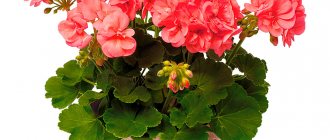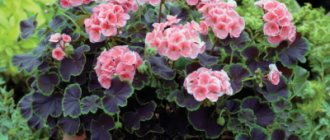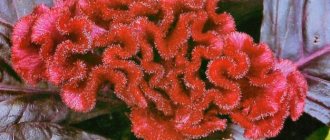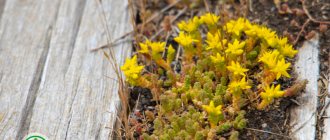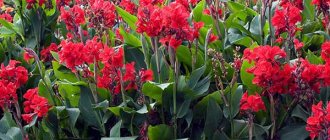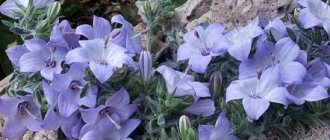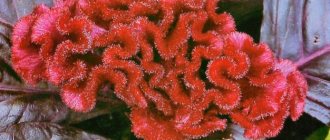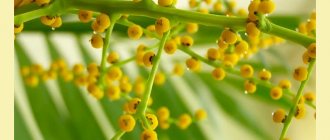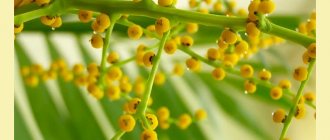Celosia is a bright and unusual plant that can be grown both in the garden and on a windowsill in a pot. The plant is represented by annual and perennial varieties, but in the domestic climate all garden celosias are grown as annuals.
It is noteworthy that celosia inflorescences are often compared to tongues of flame, and the name of the plant is literally translated from Latin - “flaming” .
Description of the Celosia flower
Celosia is an edible ornamental plant (less commonly a shrub), which in our latitudes is most often grown as an annual crop, since it cannot withstand sub-zero temperatures. The name "Celosia" means "burning" in Greek. The genus consists of about 45 species of herbaceous plants of the amaranth family (Amaranthaceae), native to tropical America and Africa.
Depending on the variety, plants grow to different sizes. Some reach a height of only 30 cm, while others can grow up to one meter or more. Scallops can have straight or branched shoots. The leaves have a lanceolate or ovate configuration.
Flowering of Celosia begins in the summer and often continues to bloom until the onset of autumn cold weather. The inflorescences are comb-shaped, paniculate or spike-shaped, formed from miniature flowers. It is difficult to find a flower with a more interesting shape and structure. The flowers of some varieties of Celosia look like flames, decorating your garden. The color of the inflorescences is quite varied - it can be pinkish, orange, golden, red, scarlet or yellow. The fruit is a multi-seeded capsule.
Types and varieties with photos
Of the entire species diversity, only three plant species are used for cultural breeding.
Spike, spike or Hutton's celosia (Celosia spicata)
This variety is not particularly popular among gardeners because it is considered paler and less expressive than other species.
However, it has undeniable advantages, for example, the height of the bush easily exceeds the meter mark and can reach 1.3 m.
Another advantage of Hutton's celosia is its resistance to frost and low temperatures.
The bushes of this spicate beauty branch well, and due to their large size, they are readily used by florists to create decorative compositions of dried flowers.
Silver comb or cockscomb (Celosia argentea f cristata)
The height of the plant is small - the maximum size is about 0.6 m, but most varieties are even lower.
Attention! The variety is not found in natural conditions; it is grown only in cultivated form.
Celosia attracts attention with the unusual structure of the corolla of the flower: the fused edge of the petals bends, forming intricate combs (hence the name of the variety).
also adds a resemblance to a cock’s comb – all the colors are bright and incredibly rich :
- red;
- crimson;
- deep pink;
- yellow;
- orange.
Silvery pinnate or paniculate celosia (Celosia argentea f plumosa)
This variety is considered the most popular for garden and indoor growing. (copper, golden or bronze) attract attention .
Impress
One of the most picturesque forms of the comb type of celosia . The deep purple leaves and stem make an excellent backdrop for the vibrant wine-red inflorescence.
Imperialis
A dwarf variety, the height of the bushes does not exceed 0.25 m. The leaves give off a purple tone, becoming an advantageous background for the rich burgundy comb inflorescence.
Atropurpurea
The comb celosia variety is distinguished by its bright, rich red inflorescence and abundant pubescence. Bright green leaves with pink straight stems also add charm.
Pampas
The variety belongs to the pinnate group of plants. Reaches a height of 0.8 m and has a well-branched stem. Often appears in a mixture of colors.
Golden flitz
One of the most popular varieties of silvery feathery celosia. The bush is well formed , well branched and attracts attention with large panicles of rich orange inflorescences.
Feuerfeder
Low-growing variety, shoot height does not exceed 0.35 m . Against the background of light green large leaves dotted with red veins, rich red paniculate inflorescences stand out brightly.
How to grow Celosia in the garden
These flowers are fairly easy to care for, but the Scallop has a few special requirements. We recommend checking out our complete planting and care guide to help you grow your own Celosia plant.
You can buy seedlings of the flower at your local nursery or garden center, but it is also easy to grow from seeds.
Sowing Celosia seeds indoors for seedlings
The best method for growing Scallops from seed is to sow seedlings indoors about 6-8 weeks before the last average spring frost date.
Here's what you'll need:
- Celosia Seeds
- Container for seedlings or peat pots
- Good quality soil mixture for seedlings
- Artificial lighting or a well-lit window
- Warming mat (optional)
The process of planting Celosia seeds for seedlings is as follows:
- Moisten the soil, but do not oversaturate it with moisture. By squeezing a lump of soil with your hand, it should not fall apart, but water should not flow from it.
- The seeds can be pre-soaked for several hours.
- Fill trays or peat pots with moist soil mixture and sow seeds on top of the soil, one per cell or pot. Celosia seeds need light to germinate, so you should either just press them lightly into the soil or barely cover them with a small amount of soil.
- Place trays or pots in daylight. This could be a window that gets a lot of sunlight, or lighting for plants.
Seeds germinate best at a temperature of 20-26 °C. If your home tends to be cool in the winter, a heating mat can help to warm up the container from below. Keep the soil moist during the germination period. You can cover the trays with plastic lids or plastic wrap to retain moisture. Germination should occur in 1-2 weeks. Once you have seedlings, thin out the weakest ones, leaving only the strongest seedlings for planting outside.
Once your seeds have sprouted, remove the lid and it is advisable to increase the amount of light received. Water the seedlings and give them good ventilation while they sprout. Harden off the seedlings about 2 weeks before transplanting them into the garden.
Temperature and watering
Although celosia is an unpretentious crop, it still needs some care after sowing and planting in the ground. Keep in mind that the plant is absolutely not compatible with high soil moisture and does not react well to drafts, so both the planting site and the watering schedule should be selected very carefully.
Figure 5. Watering the flower should be regular, but not too abundant.
The crop should be watered moderately, since celosia does not tolerate waterlogging of the soil, but does not develop actively enough when it dries out. Ideally, moisture is applied daily in the morning, but in too hot weather it is better to postpone the procedure to the evening. However, if there is natural precipitation, watering can be temporarily stopped.
Water for irrigation is also not quite ordinary. Firstly, it should not be hard, so it is advisable to let it settle, or use collected rainwater. Secondly, the liquid should not be cold. Use only ambient temperature water. Otherwise, the root system of the plants will experience severe shock and the flower will die, even if it has enough heat and light (Figure 5).
Planting Celosia seedlings or seedlings in the garden
What you need to know when planting Scallop in a flower garden.
When to plant
Celosia is sensitive to cold, so wait until all frosts have passed in the spring. This also applies to direct sowing of seeds. Be careful as this is a heat-loving plant. Wait until the soil has time to warm up. Typically, seedlings are planted in early to mid-May in colder climates and April in warmer regions.
Where to plant Celosia: choosing a place
You can grow the flower in open ground or in containers. Scallops are equally good in both cases, but if you plan to use containers, it is advisable to choose varieties with shorter stems.
Celosia loves sun and warmth, so find a place where the flower will receive enough sunlight. These plants need at least eight hours of sunlight every day.
What soil is suitable for growing scallops?
The flower is drought tolerant, but does not like stagnant water, so make sure your planting site has good drainage. It's the same with pots. Use a good quality potting mix that drains well, and make sure your pots have drainage holes in the bottom.
If you have clay soil on your site, it is best to mix it with perlite or coarse sand before planting the seedlings. It will be better if you add some nutrients to the soil. Add compost before planting to add organic matter to the soil.
Planting Scallop seedlings
Celosia can be planted just like any other seedling. Once you've prepared your flower bed or container, simply dig holes that are roughly the same size at the root balls of your plants. Make sure the soil is well warmed up before planting Celosia.
If you grew your seedlings in peat pots, you can plant the seedlings in them, but tear off the bottom of the container so the roots have somewhere to grow. Otherwise, carefully remove each seedling from the pot and insert it into one of the holes. Cover each seedling with soil so that the top of the root ball is covered with soil. Lightly tamp them down with your hands to prevent them from falling.
The last step is to water the planting area well. To prevent weed roots from killing your seedlings, when planting your seedlings, apply a few inches of organic mulch around the seedling to prevent weeds from germinating.
Comments (2)
Alexandra
06/03/2019 at 21:25 |
I first saw Celosia when I was almost thirty years old. It doesn’t grow on our streets, but one employee brought it to work from home. Then we all marveled at such beauty. I tried growing it at home, and it bloomed for a while, but then died.Answer
Yulia Expert Plodogorod
06/04/2019 at 23:06 |
Hello, Alexandra! Let's take a closer look at the features of caring for this plant, as well as the probable causes of the death of the flower, in order to prevent the problems from reoccurring in the future.
The planting location should be sunny, protected from wind and draft. Celosia prefers loose and slightly acidic soils. If the site has heavy and dense soil, it is better to add sand and peat to it. In addition, it is better that the soil is pre-fertilized. We recommend using rotted compost for this. This will also make the soil looser, not just nutritious.
It is better to plant a flower in the first days of summer. If the seedling method was used for cultivation, be sure to systematically weather and harden the seedlings. You can start with a few hours on the balcony or veranda, and then, immediately before transplanting into open ground, you need to let the flowers spend the night outside several times.
It is better to plant from containers with seedlings using the transshipment method in order to injure the rhizome less. This plant does not bloom well if it lacks moisture. Also, feeding with complex mineral products will not be superfluous.
The most common problem with this plant is the fungal disease blackleg. Most often, seedlings or recently planted specimens are affected. But adult flowers are not immune to this. The disease appears as dark spots at the base of the stem. Over time, the area becomes soft and dies.
To avoid such difficulties, you should use non-cold water when watering seedlings. And in addition, disinfect the soil before sowing seeds and transplanting adult plants. This can be done using a solution of manganese or some drug, for example, Fitosporin.
Also, we do not recommend thickening the plantings. The distance between seedlings in the seedling container should be at least 5 centimeters. Adult bushes are planted at a distance of 30 centimeters.
Fungal diseases can occur from excess watering and stagnant moisture. To prevent this from happening, it is necessary to water slowly, then the moisture will have time to be absorbed. In addition, it is worth observing the requirements for soil looseness and laying a layer of drainage in the planting hole.
Answer
Sowing Celosia seeds in open ground
You can grow Scallop by sowing the seeds directly in the flower bed. This method has its pros and cons.
Celosia seedlings do not always tolerate transplantation, so sowing seeds directly into the ground avoids this problem. However, if you live in more northern regions and don't have a long growing season and your plants will take a while to flower - you may miss out on most of their flowering time.
If you live in a milder climate with a long season, starting your seeds outdoors is your best option. Celosia usually begins to bloom in mid to late summer. The flowering period will take longer if you decide to plant the plants from seeds outdoors in the spring.
The process of sowing in open ground is as follows:
- Preparing the site. Get rid of rocks, weeds and debris. Mix compost or manure into the soil to increase nutrient levels at the planting site.
- Level the surface of the soil until it is relatively smooth.
- Plant Celosia seeds up to 3cm deep and barely cover them with soil. Remember that they will need light to germinate.
- Water the newly seeded area well and keep it moist while the seeds germinate. Once the seedlings appear, allow them to grow for a week or two. Then, if necessary, you can plant them in the right places.
Loosening the soil
It is impossible to imagine growing celosia comb without periodically loosening the soil. This procedure will help speed up the flow of air, moisture and nutrients to the roots (Figure 7).
Figure 7. Loosening is one of the mandatory stages of crop care
If you plan to grow celosia on your plot, be prepared for the fact that you will have to loosen the soil after each watering or rain. The fact is that this flower crop absolutely does not tolerate waterlogging and heavy soils, and without loosening the soil will quickly become compacted and the development of the plant will slow down.
Further care for the Celosia flower
The scallop is not a capricious plant and requires a lot of attention. You just need to follow some procedures described below.
Watering
Established plants are drought tolerant, but you will need to water the seedlings regularly until they are established. Water mature Celosia when the top layer of soil dries out. Always check the soil first to see if the flower needs watering. Never allow moisture to stagnate, as Scallop is prone to root rot, which will quickly kill the plant. Water once or twice a week in summer. Seedlings need more water than mature plants.
You might be interested
List of the best applications for identifying plants from photos
List of the best blue flowers and plants with blue foliage
Anafalis - an original garden decoration
Fertilizer
In most cases, Celosia does not need to be fertilized, but you can apply a balanced fertilizer about once a month if you want the plants to look fuller.
You can add a layer of mulch around your flowers to keep them looking nice and to suppress weeds, but don't overdo it. Soil that is too wet will cause rot.
Celosia pruning
To give the plant shape, pinch off its longer stems. Remove leaves that look unhealthy or have dried out. Do not pick the leaves; cut them off with sharp garden shears. Also be sure to remove dead flowers as this will encourage new buds to grow. Broken stems should be cut below the break point. Never leave damaged stems on Celosia, as this can lead to disease. Taller varieties of Celosia may need staking, especially if you often experience strong winds.
Cockscomb flowers - description
Celosia comb is the correct name for cockscombs. They belong to the amaranth family. They can be either annual or perennial.
Blooming cockscomb (photo)
The stem of the plant is green or reddish in color. It's juicy. The color of the leaves has a rich color palette - from green to dark purple.
The height of these plants is up to 35 cm. The flowers are small, colored in yellow, orange, red, purple and pink.
Flowering begins in July and lasts until the first half of October. So, such plants can add a touch of originality to even the most sophisticated garden composition.
Expert opinion
Yulia Yurievna
I have a large garden and vegetable garden, several greenhouses. I love modern methods of cultivating plants and mulching the soil, and I share my experience.
Ask a Question
Pests and diseases
Celosias are generally hardy but susceptible to fungal diseases. Check regularly for damaged areas on the leaves that appear as brown spots. Trim off affected leaves to prevent the fungus from spreading to the rest of the plant. Grayish-black spots on the stems may indicate root rot. Ventilate Celosia plants generously and make sure they are in an area that receives plenty of sunlight. If you keep the flower indoors, it may attract mites that feed on the sap of the leaves. To control mites, lightly spray the leaves with a mixture of one teaspoon of mild dishwashing liquid in one liter of water.
Plants that do not have time to grow stronger may become infected with blackleg.
Photo of seedling damage by “black leg”
This disease can be prevented by watering only in the morning (before 9:00 am). In cloudy times, it is not recommended to moisturize. If disease damage is detected, the soil should be thoroughly loosened and then sprinkled with wood ash, watering should be significantly reduced.
Cutting and collecting seeds
In order to collect seeds from Celosia comb flowers that can be planted next year, you should do this:
- towards the end of the season, cut off several inflorescences that are already beginning to fade;
- place them in a container (without water) and leave them in a cool, dark room;
- Shake the dried inflorescences thoroughly over a table on which sheets of clean white paper are laid out;
- separate the seeds from the litter and place them in a thick paper bag or box for storage.
Celosia flower in garden landscape design
The comb looks great in combination with decorative stones or small shrubs. Often the flower becomes an addition to voluminous flower beds and ridges.
Low-growing varieties are used in the formation of flower beds, carpets, for growing in hanging flower pots and balcony containers. Scallops can be planted either individually or in group compositions. Their celosias form beautiful bouquets; they are able to delight for a long time with their beautiful appearance.
In some countries, the plant is used for medicinal purposes - to combat vision problems and oral pathologies. In China, it is grown to make healing tea.
Celosia - colorful cockerel comb: growing, planting, care
Celosia is an unpretentious flower from the Amaranthaceae family, a perennial plant grown as an annual.
Silver celosia is the best decoration for flower beds and edgings of your garden. Celosia is also grown in pots and flowerpots at home. The homeland of silver celosia is hot Africa, Asia and South America. Over 60 species of celosia are known, but the most commonly grown species in gardens, greenhouses and indoor gardens are silver comb celosia and spikelet celosia (Hutton's celosia).
Hundreds of celosia varieties bred by breeders around the world will not let you get bored with the monotony. In this article I will give examples of just a few varieties of celosia that are most often sold in stores. You can try exotic varieties of celosia yourself if you like growing it.
By the way, people don’t know the scientific name of silver celosia - they simply say: cockscomb or cockerel. Rarely does a gardener ask for celosia in a store, and even the sellers know that a cockerel or comb is celosia. Therefore, it’s enough to remember “cockerel flower” for yourself and it’s in the bag - you can go get the seeds.
Yellow celosia inflorescences look spectacular in any environment. Pictured is Celosia cristata. Source: Wikipedia
Scallops bloom from early July until the first frost and set seeds abundantly, but the seeds do not fully ripen.
Varieties of Celosia
In nature, there are up to 45 species of Scallop, and the varietal diversity is even greater. The most popular types:
Silver Celosia (Celosia argentea)
There are also other names for this species - Celosia comb or pinnate. The height of the stem is up to 65 cm, miniature flowers create voluminous fluffy inflorescences.
The color is different - yellow, scarlet, red with purple hues. It is distinguished by a long riot of buds - from the first half of July to October. The most famous variety is “Impress”. The characteristic difference is a rich burgundy hue, dark purple leaves.
The best varieties
The diversity of this exotic flower will help you get acquainted with its most popular varieties. Among them there are dwarf, medium and tall. They differ from each other in the size and shape of the inflorescences, the color of the flowers and leaves.
Coral Garden
The varietal series of celosia comb Coral Garden is represented by low plants, the length of the shoots usually does not exceed 30-40 cm. The bright colors of the “combs” are from 10 to 20 cm wide, ranging from light yellow to a deep shade of fuchsia. The leaves are colored in rich green tones. Most often, the seeds of this comb celosia are sold in the form of a mixture. The coral garden looks great cut and dried.
The Coral Garden variety series impresses with its variety of colors
Empress
Luxurious Empress, or Empress, also belongs to the dwarf varieties of comb celosia: the height of its shoots is usually 30 cm. Its distinctive features are dark green leaves and large burgundy-red “crowns”. It is often grown as a balcony crop.
The burgundy-red “crown” of the Empress looks luxurious and majestic
Atropurpurea
The celosia comb variety Atropurpurea does not grow tall - only about 25-30 cm. It is characterized by an unusual color of the stems, combining green and soft pink tones. At the tops of the shoots there are very large inflorescences of a rich purple-red color. The leaves are oval, light green, with pink veins.
The beautiful Atropurpurea has unusual light green leaves with pink veins

